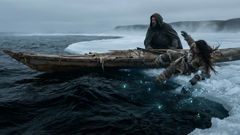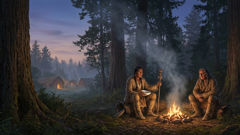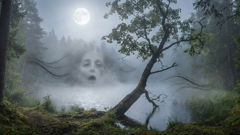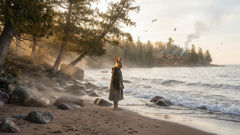Introduction
Under the brittle vault of Arctic sky, where ice sheets ripple like sleeping mountains and the ocean breathes a slow, cold rhythm, the myth of Sedna is told in voices that have crossed generations. She is both storm and stillness, an origin and a warning, the woman who became sea and sovereign of all that swims beneath the ice. For the Inuit, Sedna is more than story; she is a living force whose moods shape harvests and whose wrath can starve a camp, so the tale that begins with a daughter, a father, and a cruel betrayal becomes a map for survival. In the hush after the hunt, when kayaks glide home and hunters set their blubber lamps to glow, elders speak of the day the sea took a girl and the sky kept its silence. They speak of hands that would not let go, of fingers torn and flung into the dark, and of a woman reborn in cold salt as the great mistress of seals, whales, and fish. They teach why the shaman must comb hair that will not grow, why offerings of skin and oil are set adrift, why Inuit singers chant to the edges of the ice: for Sedna remembers. She remembers the hunger of abandonment and the sharp geometry of betrayal; she remembers the world as it was before she learned to command tides and creatures and the chambers beneath the sea. This is a telling that connects geography and grief, law and survival, a myth that binds people to place: an Arctic hymn sung to keep the balance between those who live by the sea and the living sea itself. Listen to it with care, for Sedna hears even the smallest plea made in the wind.
Birth and Betrayal
The story begins inland, where the land folds like an upturned hand and families cluster against the weather. In one such camp, a girl was born whose beauty held the soft harshness of the Arctic coast: dark hair like wet kelp, eyes the green-gray of pack ice in thaw. Her mother died when the infant's breath first fogged the air. The father—an awkward man whose laughter had thinned into a quiet reserve after his wife's passing—found himself raising a child he had not expected. He called her Sedna, a name that would come to carry both tenderness and terror. Sedna grew under a sky that never promised warmth. He taught her to sew leathern sealskins with patient fingers, to weave nets that could hold the silvered rush of fish, to mind the small rituals that kept wind and tide inclined toward favor. Yet in corners of their tipi, whispers gathered like shadows: he was a man who mourned and who feared his own solitude, and in the ache of loneliness he made choices that would sunder more than his own heart.

As Sedna moved into the restless years between childhood and womanhood, the father's decisions grew stranger. He sought companionship in the unpredictable forms of outsiders—men who came with promises, who wore foreign ornaments and tasted of different fires. He wished to bind her with one of these men and so to close the long, echoing silence of the tipi. Sedna resisted. She had an inner temper, a stubbornness born of the land itself, where life is coaxed from the smallest means and nothing is given free. Once, when a suitor came with hands that smelled of oil and blood, she fled to the edge of the bay, where the ice hemmed out its lace and creaked like an old drum. Her father followed, pleading. His words were uneven, backed by the raw insistence of a man who believed that in marriage lay his safety and the family's success. But Sedna's spirit would not bend to make another secure. The sea watched, patient and impartial, as filial bonds snapped and bartered like driftwood.
The suitor and others returned, and the father, feeling the ground of propriety shifting beneath him, made a choice that broke the thin line between human failing and cosmic consequence. In some tellings, he pushes her from a skin-covered kayak into a sudden cold that smokes the air; in others, he leaves her to frost and tide amid a storm spun by the jealous winds. The horrifying detail—so haunting it etches itself into memory—is of how the father, in a panic and in fear for his own survival, grabs at his daughter's hands as she is swept away. Her fingers, cramped with the water's death, cling to the gunwale. He is unable to bring her back into his boat and, in a single, monstrous act, severs her fingers to free himself and throws them into the sea. As each severed finger drops into the dark, it transforms: a seal flops, then a walrus rises, then a fish darts, each piece bursting into life below the waves. The brutality of the act births abundance and pain at once. Sedna does not die in the simple sense. Instead, she sinks, submerged in salt and grief, the watery world wrapping her as it alters her. Her broken hands, the prime instruments of sewing and of kindness, become generators of the sea's harvest, and Sedna herself is remade into a being whose sorrow is braided to the hunger of fishermen.
The people who tell this story do not do so to punish the father alone. The tale is a living mechanism by which communities remember the fragility of trust and the ways one person's desperation can doom another. It is also an explanation: Why do the seals come when they come? Why does the whale sometimes refuse to appear? Sedna's heart, they say, carries a harvest and a withheld harvest; when she is angered—by neglect or by slights to ritual—her creatures hide in the deep. The shaman must then voyage through trance and song to the undersea house she inhabits, to comb her hair, to free the fingers that cannot grow, to persuade the Sea Mother to release the animals once more. The ritual is not merely transactional; it is a recognition that human error ripples into the environment around it, that personal betrayals reverberate into collective survival. This is the moral scaffold of the myth: the sea grants and withholds not out of whim, but as a mirror to human action and as an assertion that connection and respect are necessary for continued life. In this early act of betrayal, Sedna's transformation becomes a cautionary song to fathers and to hunters, to families and to the wild: the ocean remembers what humans have done, and the water keeps score in the living bodies that pass beneath the ice.
Sedna’s Reign Beneath the Ice
After the storm and the severing, Sedna’s story takes on new dimensions. She does not simply become a goddess in the way crops become a harvest; she becomes curator and keeper of a realm with its own logic and etiquette. Under the ice, a palace of dark blue and shifting light awaits—rooms carved of whale bone and kelp, corridors hung with the pale skins of seals, and windows made of frozen breaths that show the flicker of human life above. Sedna sits there like a queen no one invited, combing hair that tangles and recoils with every remembered betrayal. Her fingers, broken and transformed, cannot knit the ordinary warmth of human community anymore; instead, each fingertip is the seed of a species. She commands the seals and whales, the walrus and cod, and she weighs the offerings that drift down from the human world: oil, a carved figure, a sung lament, the soft warmth of a child's prayer. If offerings are careless, or if a hunter boasts beyond measure, Sedna shuts the doors of her underwater halls. The sea grows thin with food; nets return empty. Camps grow silent with hunger, and in that silence the people remember the story and the obligation etched into it.

Shamans, who move between worlds, become mediators in a literal sense. They slip into trances by drum and song, letting the breath turn them toward the deep. Their hair loosens, their lungs burn, and their spirits dive while their bodies remain in tipi. In those dark, inductive journeys the shaman meets Sedna as a sovereign who keeps both the memory of her suffering and the instruments of abundance. The shaman combs her hair, sings the lines that smooth the knots she has harbored since betrayal, tells her that the people of the ice remember the wrongs and have learned to respect the sea. Often the shaman must present a reparation: a carved seal-skin, the blood of a hunted animal, or a symbolic restoration of fingers in the form of ritual objects. When Sedna is mollified, she loosens her grip on her creatures and the hunters find their luck returned. The ritual is as much about acknowledging shared responsibility as it is about appeasement. Sedna's domain thus functions as a moral barometer; the condition of the hunt reflects the degree of harmony between people and sea.
Sedna's character is complex. She can be described as vengeful because she withholds, but she is also a protector of the creatures she rules. Stories told by drumlight emphasize that Sedna punishes not out of mere spite but out of severe, ineffable grief. Every animal she commands is a testimony to the violence done to her hands; every hunting success is a partial reconciliation. In some narratives Sedna is depicted as stern but fair, doling out abundance only when humans do right by the laws that sustain them: respect for life, careful use of resources, and the honoring of kin. In others she becomes a darker force, jealous and unending in her recall. The differences across tellings matter because they show the adaptability of myth to circumstance: a community that has recently faced scarcity may emphasize Sedna's wrath, while one living in relative plenty may recall her as guardian mother. These shifts in portrayal are not contradictions, but rather ways to teach what each generation needs to hear.
The elemental imagery woven through accounts of Sedna is vivid and instructive. Imagine the icy undersea palace lit by bioluminescent algae, a faint auroral glow slithering across the ceiling of packed snow. Think of the whale as a dark cathedral, its ribs stained with the passage of time and the breath of prayer. Picture nets full of glinting fish being passed like offerings to a submerged altar. Such images give the myth its didactic power: the natural world is alive and full of agency; it requires humility and ritual; it can be generous if one learns to read its signs. Salmon run and then hide; whales surface then vanish; seals warn the coast with their long calls. People interpret these shifts as Sedna's moods, and from those interpretations they craft behavior—offerings left in small bowls, songs hummed into the wind, a shaman's midnight voyage—that reorders their relationship with the sea.
Sedna’s influence extends beyond the practicalities of food. She also acts as a mediator between life and death, a custodian who takes in the souls of those claimed by the sea. In funerary stories, those lost to waves are received into the folds of her realm, where their spirits are shaped into something that can warm the community’s memory. The myth thus bridges survival with meaning: the sea’s bounty is both physical and spiritual. Sedna's underworld functions like a ledger and a sanctuary, cataloging offenses and sheltering the dead in equal parts. Elders teach children that to ignore Sedna is to cut one's tie to ancestors and to the rules that have kept communities alive in the Arctic long before contact with outsiders. This is why the myth remains vital; it is a living architecture for social ethics, ecological stewardship, and the emotional geography of loss.
From a cultural perspective, Sedna’s tale is also a story of agency reclaimed. The girl who was pushed and had her fingers severed becomes an entity with power enough to determine the rhythms of winter hunts. Her transformation is not merely punitive; it is a metamorphosis where suffering crystallizes into sovereign authority. The sea becomes her instrument, and her insistence that she be honored forces humans to face the moral cost of their actions. She flips the script on victimhood: the wound becomes a source of power. But power so derived compels careful governance; Sedna's reign is not easy to manage, and only through ritual, humility, and remembrance does the human world continue to receive what it needs. Her story insists that to live by the sea one must be willing to listen to it, to confess errors, to stitch together a fragile honor with offerings and songs. In this way, Sedna stands at the confluence of narrative and survival, a goddess who is as much a rulebook for living in fragile ecosystems as she is a haunting and beautiful figure carved by Arctic imagination.
Conclusion
The myth of Sedna remains more than a tale to end a long Arctic night. It endures as an instruction carved into the lives of people who must reckon with weather, water, and one another. Sedna’s transformation from a forsaken girl into the sea’s sovereign teaches about consequence: actions that violate trust ripple outward and the natural world keeps its own account. But the story also offers a path back—a set of communal behaviors and rituals that demand acknowledgement, repair, and humility. Through shamans and songs, through offerings of oil and carved amulets, people relearn their place in a world where meals depend on weather and memory, where the undersea palace both yields and withholds sustenance. In modern retellings, her tale continues to adapt, informing conversations about stewardship, the rights of nature, and the cultural memory that anchors communities through change. Sedna is thus not a relic but a living symbol: a goddess who holds the sea’s abundance and whose anger can starve a village, but who can also restore life when people repair the bonds they once broke. To speak her name is to recall the cost of betrayal and the labor of restoration; to listen is to learn a way of living that honors both the human and the more-than-human beings with whom survival is shared.













